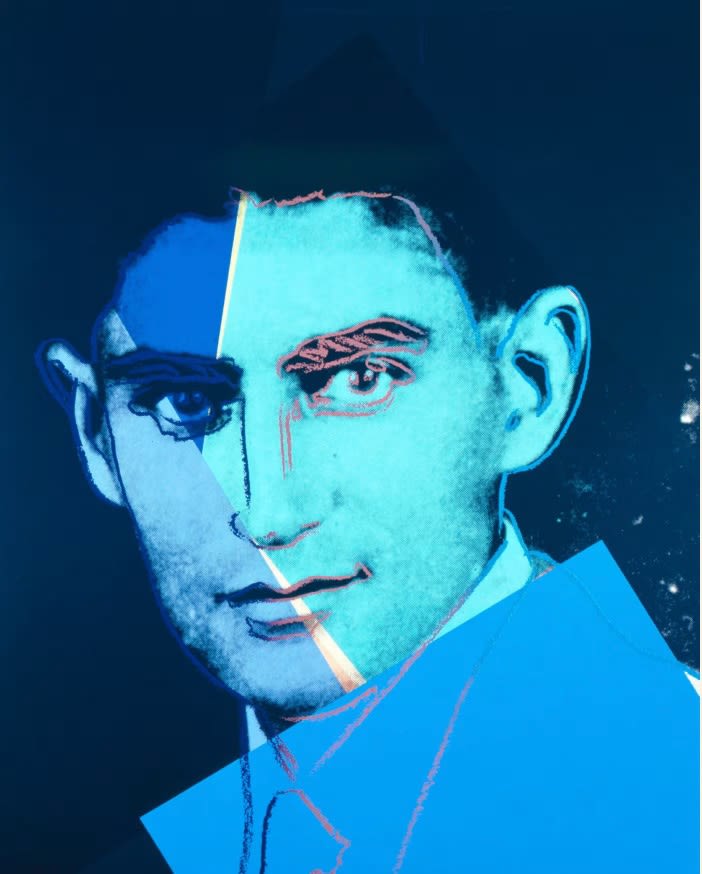
The Financial Times published a 'Books Essay' at the start of June which includes a portrait of Franz Kafka produced by Andy Warhol in 1980. This recognisable portrait of Kafka, with his head titled, his mouth subtly smiling in the corner, his direct, fixed gaze, has been modified by Warhol who applied varying hues of blue across the portrait. Abstract shapes contain varying depths of blue tones, whilst some features are accentuated - the outline of his face, eyebrows, ears, nose, mouth, shirt - are defined through a scrawled crayon-like line in two shades, as though Warhol is re-drawing or reinterpreting his face, making it his own. This layering of shapes and hues gives an almost collage-effect in the collision of components which creates a more complex creation. The vivid colours metamorphosise the black and white portrait to a 1950s Pop Art creation.
Warhol’s Portrait of Franz Kafka: Colour, Technique and Transformation
This print of Franza Kafka is from the series ‘Ten Portraits of Jews of the Twentieth Century’ which is a series of ten screenprints published by Andy Warhol in 1980. Alongside Kafka, the ten portraits also include Gertrude Stein, Martin Buber, Albert Einstein, Louis Brandeis, George Gershwin, The Marx Brothers, Golda Meir, Sarah Bernhardt and Sigmund Freud. In the same year, these portraits were exhibited at the Jewish Museum in New York.
Each of the subjects of Ten Portraits are created through mixed media – illustration, the use of coloured artist papers that give the appearance of collage, and reappropriated photographs. The final process of screenprinting or silkscreening allows Warhol to finally consolidate his portrait with stencilled plates that are then used to impress ink on the surface. Though all employ a similar process, the difference seen in each example is astonishing: each portrait appears to be its own kaleidoscopic rendition of the sitter’s inner world. Warhol’s Jewish figures form a vast interdisciplinary landscape across politics (Golda Meir), theatre (Sarah Bernhardt and the Marx Brothers), psychology (Sigmund Freud) and literature (Franz Kafka), so the distinction with which Warhol paints his sitters is in keeping with their accomplishments.
The Significance of Ten Portraits of Jews of the Twentieth Century
Though the portraits do not feature any external objects or indications of their professions, Warhol seems to subtly imbue them within colour and form. For example, Kafka appears entirely in a spectrum of light to dark blue: the author was known for keeping diaries known as ‘The Blue Octavo Notebooks’, which will be published this year to mark the centenary of his death, and also had a plaintive sensibility that might be best symbolised in blue. Similarly, hand-drawn chaotic spirals appear to emit from composer George Greshwin’s head, as if to mirror the innovative musical rhythms for which he was known in jazz and in classical music.
Symbolism, Reception and Legacy of the Series
As a series, Ten Portraits of Jews of the Twentieth Century had a polarised reception when it was first released. The idea for the portraits was conceived by Warhol’s dealer, Ronald Feldman, and the subjects were chosen by Susan Morganstein, art director of the Jewish Community Centre in Washington. However, when the works were exhibited in New York, some responses were critical.
As a series of portraits of an ethnoreligious group that has faced persecution, it would be hard to imagine a scenario where, painted by a non-jew (Warhol came from a Catholic family) they would not be subject to critique. However it is worth considering that Feldman, Warhol’s dealer, was himself Jewish, as were many patrons and friends of Warhol. At their most fundamental level, Ten Portraits pays homage to the Jewish intelligentsia in a way that few artists captured except Warhol. Since their initial exhibition, Ten Portraits of Jews of the Twentieth Century was exhibited at the National Portrait Gallery in London, cementing their international recognition as historical portraits of important Jewish figures.
For more information on Andy Warhol prints for sale and to buy Andy Warhol prints, contact sales@andipa.com or call +44 (0)20 7589 2371
